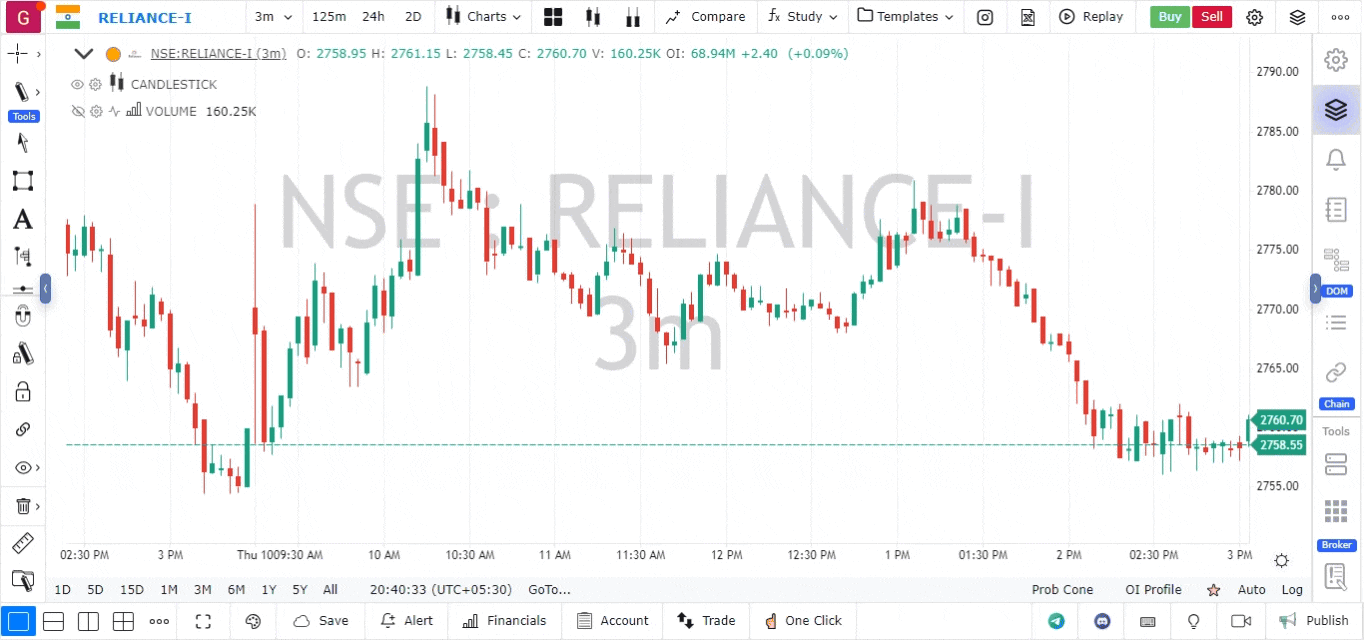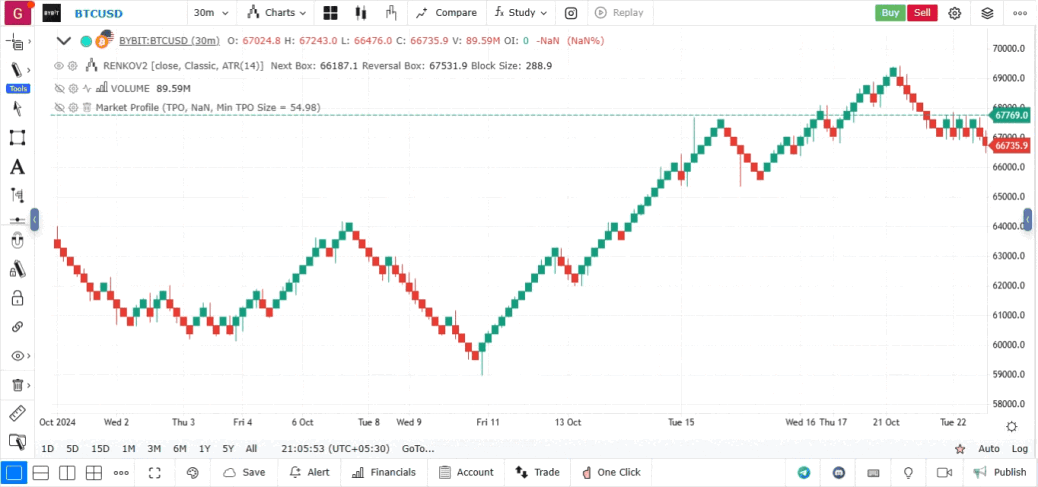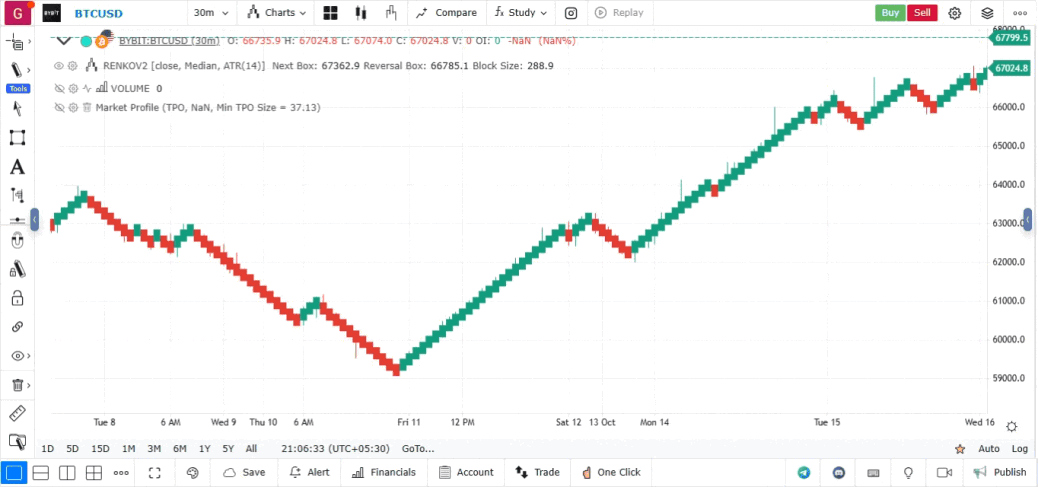Renko
General info
Renko chart is completely time-independent, based on price movement only and help filter out the noise that can occur on other chart types. Renko is built from bricks, which are created only when the price exceeds the body of the previous brick by a certain size, which is set by the trader in the chart parameters.

Renko Charts in GoCharting
It is important to note that new bricks are only added when price movements completely fill the predetermined brick size. Prices may exceed the values of the previous brick (either above or below), however a new brick will not be formed until the price movement is large enough. For example, let’s say the brick size is set to 2 points and the last brick covers prices of 54. The new brick won’t be formed until prices close either at or above 50. If price closes above 57; the new brick must still stop at $56.
There are two rules regarding brick placement:
- Bricks will always have their corners touching.
- There can never be more than one brick in any one vertical column.
Brick types
There are four different brick types, generated by a gocharting.com renko chart:
- Up Bricks — Bricks that form above the previous brick.
- Down Bricks — Bricks that form below the previous brick.
- Projection Up Bricks — During an intraday timeframe, a potential up brick that would form based on current price (before actual closing price is set).
- Projection Down Bricks — During an intraday timeframe, a potential down brick that would form based on current price (before actual closing price is set).
Brick calculation
There are two different methods for calculating bricks:
Average True Range (ATR)
- Uses the values generated by the Average True Range (ATR) indicator. The ATR is used to filter out the normal noise or volatility of a financial instrument. The ATR method automatically determines a good brick size. It calculates what the ATR value would be in a regular candlestick chart and then makes this value the brick size.
ATR Persistence
- The ATR method mentioned above suffers from a serious demerit of using the ATR value computed based on prior 14 days candles from the current value at the time of chart activation. As a result, reloading the browser and chart will change the ATR value over time and will change the structure of the bricks. The ATR Persistence method uses a rolling 14 day ATR calculation methodology which is dynamics and as a result the size of the brick changes over time depending on the underlying volatility of the price in the past. The Renko brick structure remains static and does not warrant a repaint making it the most stable form of Renko charts using candle data.
Fixed
- Uses a user-pre-defined absolute value for brick size. New bricks are only created when price movement is at least as large as the pre-determined brick size. The upside to this method is that it is very straightforward and it is easy to anticipate when and where new bricks will form. The downside is that selecting the correct brick size for a specific instrument will take some experimentation. Typically, you will want to select a brick size that is about 1/20th of the current value of the instrument.
Price %
- Uses an % increase or decrease in price to determine the box size. Since it is a % normalized hence the aboslute value of the price increase and decrease will vary at every candle level. This is an extremely powerful setup to filter out noise
Calculation styles
In the Renko chart settings, you can choose one of several styles based on which the chart will be drawn:
Close
- Using closing price (or last price) only
Renko Settings
High / Low
- Using high and low prices. If the previous brick was growing, then the current brick takes into account high prices first, and then low prices. If the price drops, the method takes into account the low prices first, and then high prices.
- Show wicks — allows you to add wicks to Renko bricks, indicating actual highs and lows within a brick.
Non-standard Renko Type
Medium Renko
Smoothes out the chart more than Classic Renko because an open price is in the middle of a brick. They will show fewer pullbacks and trend reversals are easier to spot. An extension and inversion value of 50% would create Median Renko bricks.

Median Renko
Geometric Renko
Will give you very smooth reversals, and the charts are smooth out more than with Median Renko. One special property of these Renko form is, that when using an extension and inversion percentage of 12.5%, the slope of up-bricks will be 45° and for down bricks -45°

Geometric Renko
Turbo Renko
Smooths out the majority of pullbacks and only shows high probability reversals. Turbo Renko is using the extension 12% of the brick and the inversion of 100%. Price has to reverse by a complete brick to form a reversal, illustrated as the dashed bricks.

Turbo Renko
Advanced Renko
Allows you to create your own Renko structure based on user input values on Extension and Reversal

Renko Charts in GoCharting come with additional commentary to include important pivotal brick levels
Uses of Renko Charts
Traders who use Renko charts typically do so because they are easy to use and interpret. They are also different from atypical candlestick chart because they filter out all other variables besides price movement. There are many uses for Renko Charts, with some of the more popular uses being the chance to discover basic support and resistance levels, breakouts, and to generate signals with additional indicators.
Support and Resistance Levels — Frequently, when using Renko Charts, trading ranges appear when bars are generated between levels of support and resistance.
Breakouts — Breakouts occur when bars begin to generate in a defined direction after a period of trading within a support and resistance bound trading range.
Overbought/Oversold — A good example of using additional indicators within a renko chart to identify trade signals would be using the RSI in conjunction with renko bars to define overbought or oversold levels.
Please note that Renko brick prices are inherently synthetic because of their nature and therefore, they do not reflect market prices at any precise moment in time, as normal bars do. While Renko bricks may provide a useful interpretation of price activity in discretionary trading, using them to backtest, where order fills must reflect actual market prices at a specific time, is not recommended. Backtesting orders filled at Renko chart prices will inevitably be inaccurate